
Barnack is a village and civil parish, now in the Peterborough unitary authority of the ceremonial county of Cambridgeshire, England and the historic county of Northamptonshire. Barnack is in the north-west of the unitary authority, 3.5 miles (5.6 km) south-east of Stamford, Lincolnshire. The parish includes the hamlet of Pilsgate about 1 mile (1.6 km) northwest of Barnack. Both Barnack and Pilsgate are on the B1443 road. The 2011 Census recorded a parish population of 931.
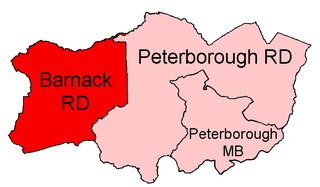
Barnack was a rural district in the Soke of Peterborough and later Huntingdon and Peterborough from 1894 to 1974.

Stamford railway station serves the town of Stamford in Lincolnshire, England, and is located in St Martin's. The station is 12.5 miles (20 km) west of Peterborough. It was opened by the Syston and Peterborough Railway, part of the present day Birmingham to Peterborough Line. CrossCountry operate the majority of services as part of their Birmingham to Stansted Airport route. It is owned by Network Rail and managed by East Midlands Railway
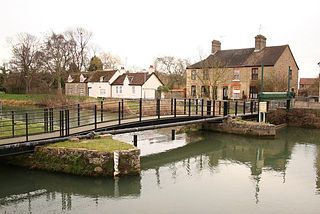
Stamford Canal, now disused, is one of the earliest post-Roman canals in England. It opened in 1670, around 100 years before the start of the Industrial Revolution which brought about the "golden age" for canals in Britain. Parts of the route can be traced on the ground, though only one lock survives intact. It was part of the Welland Navigation in Lincolnshire. First authorised in 1571, during the reign of Elizabeth I, construction did not start until 1664, under powers granted in 1620 and ratified by James I. It ran for 9.5 miles (15.3 km) from Stamford to Market Deeping and had 12 locks, two of which were on the river section at Deeping St James. No plans of its construction survive, although one of the locks was documented by a visiting water engineer in 1699. It contributed to the wealth of Stamford, allowing barley to be transported to the town for malting.
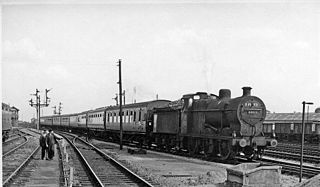
Peterborough East was a railway station in Peterborough, England. It was opened on 2 June 1845 and closed to passenger traffic on 6 June 1966. Located on Station Road just off Town Bridge, only the engine sheds and one platform remain. The station had services running west to Northampton and Rugby, as well as to the east to March, Wisbech, and Norwich.

Tallington is a village and civil parish in the South Kesteven district of Lincolnshire, England. The population of the civil parish at the 2011 census was 497. It is situated 4 miles (6 km) east from Stamford and 8 miles (13 km) north-east from the centre of Peterborough. The village has around 200 houses.

Helmshore railway station served the village of Helmshore, Rossendale, Lancashire between 1848 and 1966.

Luffenham railway station is a former station of the Syston and Peterborough Railway serving the villages of North and South Luffenham, Rutland.

Helpston railway station was a station in Helpston, Cambridgeshire, on the Midland Railway's Syston and Peterborough Railway. It was closed in 1966. The Great Northern Railway main line runs adjacent to the Midland Railway at this point, but the Great Northern never had a station in Helpston. This was due to an agreement whereby the Midland carried materials to the site during construction of the Great Northern, and in return the Great Northern offered no competition for services on this section.

Ketton and Collyweston railway station is a former station serving the villages of Ketton, Geeston, Aldgate and Collyweston, Rutland. It is located in Geeston adjacent to a level crossing on the Ketton to Collyweston road. It is under half a mile from Ketton but over a mile from Collyweston. It closed in 1966.

Barnack railway station was a station in the Soke of Peterborough serving the village of Barnack. Despite being located adjacent to the village, the more remote Uffington & Barnack station on the Midland Railway Leicester to Peterborough line was more convenient for many journeys. Barnack station was opened by the Stamford and Essendine Railway (S&ER) on 9 August 1867; it was on the S&ER's branch from Stamford to Wansford. The S&ER was leased to the Great Northern Railway at the end of 1892. The line never really recovered from the 1926 general strike, and the station closed with the line on 1 July 1929. In 2014 the building survives as a private house.
Bainton Gate railway station was a short lived railway "station" in the Soke of Peterborough on the Syston and Peterborough Railway serving the village of Bainton. It was located at the level crossing on the Bainton to Tallington road. The crossing keeper's cottage survives and is now a private house. According to The Syston and Peterborough website, this cottage doubled as the station building. The station closed on 1 August 1856.

Kildwick and Crosshills [sic] was a railway station off Station Road in Cross Hills, North Yorkshire, England. It served the villages of Cross Hills, Cowling, Glusburn, Kildwick and Sutton-in-Craven.

Stamford East railway station was the Stamford and Essendine Railway station in Water Street, Stamford, Lincolnshire. The line was worked by the Great Northern Railway but retained its independence until 1886, when the GNR took the line on perpetual lease.

Welford and Kilworth railway station was a railway station serving Welford and North and South Kilworth in the English county of Leicestershire. It was opened as Welford on the Rugby and Stamford Railway in 1850.
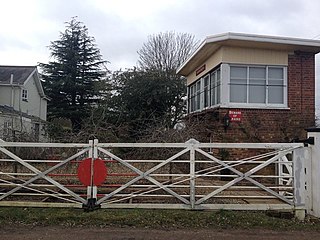
Theddingworth railway station was a railway station serving Theddingworth in the English county of Leicestershire. It was opened on the Rugby and Stamford Railway in 1850.
The Syston and Peterborough Railway was an early railway in England opened between 1846 and 1848 to form a connection from the Midland Counties Railway near Leicester to Peterborough, giving access to East Anglia over the Eastern Counties Railway. The project was part of the ambition of George Hudson to establish and maintain a monopoly of railway service over a large area of England. The surveying of the line achieved notoriety when Robert Sherard, 6th Earl of Harborough, who was hostile to railways, arranged a battle to obstruct surveys of the proposed line, and later of its construction.
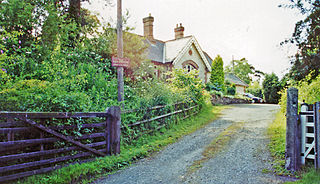
Little Salkeld was a railway station which served the village of Little Salkeld in Hunsonby parish and Great Salkeld, Cumbria, England. The Settle-Carlisle Line remains operational for freight and passenger traffic. The station was built by the Midland Railway and opened in 1876. It closed in 1970, when the local stopping service over the line was withdrawn by British Rail.

Copmanthorpe railway station served the village of Copmanthorpe, North Yorkshire, England from 1839 to 1959 on the York to Normanton line. The line also became part of the East Coast Main Line at various periods. The station was moved and substantially rebuilt halfway through its working life.
The Stamford and Essendine Railway was built to connect Stamford, Lincolnshire, in England, to the nearby Great Northern Railway. It was a short line, and it opened in 1856. It was not commercially successful, and the directors sought a means of connecting Stamford directly to Peterborough. This was the Sibson Extension, opened from Stamford to Wansford in 1867, but the junction there did not facilitate through running to Peterborough, and the Sibson Extension was even less successful than the first line. It was closed in 1929.

















